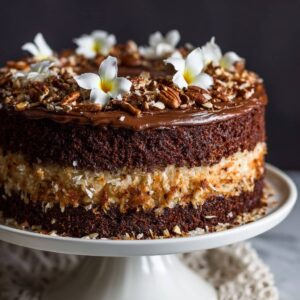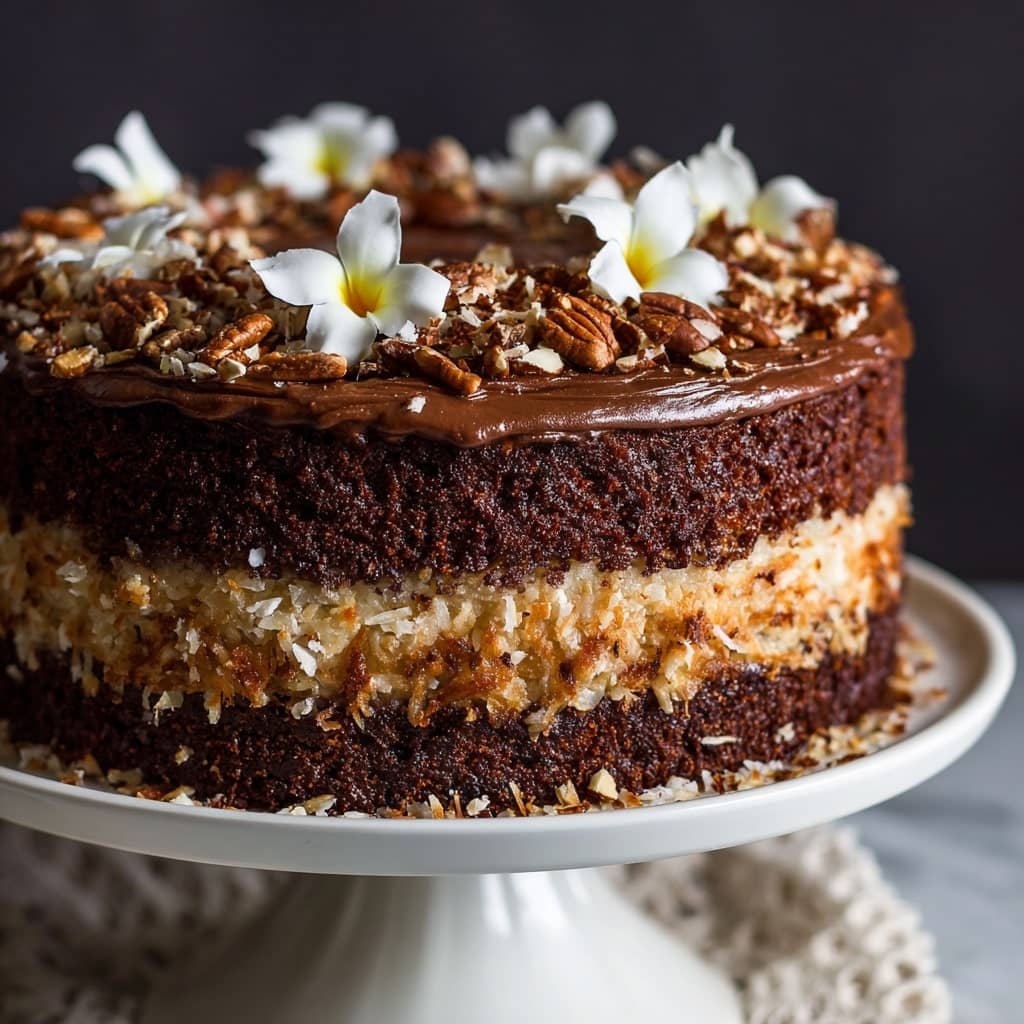The Ultimate German Chocolate Cake is an iconic dessert that stands as a testament to the richness and indulgence of classic American baking, despite its somewhat misleading name. Contrary to popular belief, German Chocolate Cake is not of German origin. The name actually comes from Sam German, an English-American chocolate maker who developed a type of dark baking chocolate for the Baker’s Chocolate Company in 1852. In 1957, a Dallas, Texas homemaker sent a recipe to a local newspaper for a rich chocolate cake that used Baker’s German’s Sweet Chocolate, along with a uniquely luscious coconut-pecan frosting. The dessert’s popularity exploded, becoming a staple in American households and an enduring favorite for birthdays, celebrations, and holidays. The cake’s deep chocolate flavor, soft and tender crumb, and signature sticky-sweet frosting make it unforgettable. Over the decades, this cake has inspired countless interpretations, from layer cakes to cupcakes to bars, yet its essence remains the same—a perfect balance of rich chocolate and nutty, creamy coconut decadence.
Ingredients Breakdown
For the Cake Layers:
- 2 1/4 cups all-purpose flour
- 1/4 cup unsweetened cocoa powder
- 1 tsp baking soda
- 1/2 tsp salt
- 1 cup unsalted butter, softened
- 2 cups granulated sugar
- 4 large eggs, separated
- 1 tsp pure vanilla extract
- 1 cup buttermilk
- 4 oz Baker’s German’s Sweet Chocolate, melted and cooled
- 1/2 cup boiling water
For the Coconut-Pecan Frosting:
- 1 cup evaporated milk
- 1 cup granulated sugar
- 3 large egg yolks, beaten
- 1/2 cup unsalted butter
- 1 tsp pure vanilla extract
- 1 1/3 cups sweetened shredded coconut
- 1 cup chopped pecans
Step-by-Step Recipe
Preheat your oven to 350°F (175°C) and grease three 9-inch round cake pans, lining the bottoms with parchment paper for easy removal. Sift together the flour, cocoa powder, baking soda, and salt in a large bowl and set aside. In another bowl, cream the softened butter and sugar together until light and fluffy, about 3 to 5 minutes. Beat in the egg yolks one at a time, mixing well after each addition, then stir in the vanilla extract and the melted German’s chocolate. Alternately add the dry ingredients and buttermilk to the butter mixture, starting and ending with the dry ingredients. In a separate clean bowl, beat the egg whites until stiff peaks form, then gently fold them into the cake batter in three additions to maintain the airiness. Pour the batter evenly into the prepared pans and bake for 25 to 30 minutes, or until a toothpick inserted into the center comes out clean. Allow the cakes to cool in the pans for 10 minutes before transferring them to wire racks to cool completely.
To make the frosting, combine the evaporated milk, sugar, egg yolks, and butter in a heavy-bottomed saucepan over medium heat. Stir constantly until the mixture thickens and reaches a pudding-like consistency, about 10 to 12 minutes. Remove from heat and stir in the vanilla, coconut, and pecans. Let the frosting cool to room temperature, where it will thicken even more and become spreadable. To assemble the cake, place one cooled cake layer on a serving plate, spread a generous layer of coconut-pecan frosting over the top, then repeat with the second and third layers. Frost only the tops of the layers and leave the sides bare in traditional style, or add a chocolate ganache around the sides for a modern twist. Chill the cake for at least 1 hour before serving to allow the frosting to set beautifully.
Tips for the Perfect German Chocolate Cake
Always use room-temperature ingredients for smooth mixing and even baking. Be sure not to overmix the batter, especially when incorporating the egg whites—overmixing can deflate them and result in a denser cake. Use Baker’s German’s Sweet Chocolate for authenticity, but if unavailable, a high-quality dark sweet chocolate can work as a substitute. Toasting the pecans before adding them to the frosting can deepen their flavor and add a pleasant crunch. If you’re baking at a high altitude, adjust the leavening agents and baking time as necessary. Let the frosting cool completely before spreading it on the cake to prevent it from running off the sides. Store the cake in an airtight container at room temperature for up to three days, or refrigerate if your environment is particularly warm.
Variations and Customizations
Though the classic three-layer cake is a beloved tradition, there are plenty of ways to adapt this dessert. Try making German Chocolate Cupcakes for individual servings or a sheet cake for easier slicing at large gatherings. Swap out the pecans for walnuts or macadamia nuts for a different flavor profile. Add a thin layer of chocolate ganache between the cake and frosting layers for extra richness. For a dairy-free version, use coconut milk instead of evaporated milk and plant-based butter in both the cake and frosting. To make a gluten-free version, substitute the all-purpose flour with a 1:1 gluten-free baking flour blend. Add a splash of dark rum or coffee to the cake batter to enhance the chocolate flavor. You can even experiment with layering the cake with a whipped chocolate mousse for an elegant and modern twist.
Health Considerations and Nutritional Value
German Chocolate Cake is undoubtedly an indulgent dessert, and its rich ingredients—such as butter, sugar, sweetened chocolate, coconut, and pecans—contribute to a high calorie and fat content. A typical slice of this cake may contain anywhere from 450 to 700 calories, depending on portion size and recipe variations. While it isn’t designed as a health food, you can take steps to make it slightly lighter. Substitute Greek yogurt for some of the butter, reduce the sugar slightly, and use low-fat evaporated milk. Using unsweetened coconut can cut down on added sugars, and choosing dark chocolate with a higher cacao percentage can provide more antioxidants and less sugar. While it’s not suitable for those with nut allergies or egg intolerances unless altered, it can be adapted with plant-based egg replacers and allergy-friendly ingredients. As with all desserts, moderation is key—enjoying a small slice of this luscious cake on special occasions can absolutely be part of a balanced lifestyle.
Frequently Asked Questions (FAQ)
Is German Chocolate Cake actually German? No, it was named after Sam German, who developed the chocolate used in the original recipe. The cake originated in the United States.
Can I make this cake ahead of time? Yes, both the cake layers and the frosting can be made a day in advance and assembled before serving.
Can I freeze German Chocolate Cake? You can freeze the unfrosted cake layers for up to 2 months. The frosting does not freeze well due to its texture.
Why is the frosting only on the top and between layers? Traditionally, German Chocolate Cake is known for its distinctive look, with frosting only between layers and on top, showcasing the cake’s sides.
Can I use store-bought frosting? While possible, homemade coconut-pecan frosting provides a much more authentic and rich flavor.
Is there a substitute for German’s Sweet Chocolate? Yes, use semi-sweet chocolate with a bit of added sugar or mix sweet dark chocolate and unsweetened chocolate to mimic the flavor.
How long does the cake last? Stored properly in an airtight container, the cake will keep for up to 3 days at room temperature or 5 days refrigerated.

Ultimate German Chocolate Cake with Coconut-Pecan Frosting
Ingredients
For the Chocolate Cake:
- 2 cups 400 g granulated sugar
- 1 3/4 cups 210 g all-purpose flour
- 3/4 cup 75 g unsweetened cocoa powder
- 1 1/2 teaspoons 6 g baking powder
- 1 1/2 teaspoons 7.5 g baking soda
- 1 teaspoon 5 g salt
- 2 large eggs
- 1 cup 240 ml buttermilk
- 1/2 cup 120 ml vegetable or canola oil
- 2 teaspoons 10 ml vanilla extract
- 1 cup 240 ml boiling water
For the Coconut Frosting:
- 1/2 cup 100 g light brown sugar
- 1/2 cup 100 g granulated sugar
- 1/2 cup 115 g unsalted butter
- 3 large egg yolks
- 3/4 cup 180 ml evaporated milk
- 1 tablespoon 15 ml vanilla extract
- 1 cup 120 g chopped pecans
- 1 cup 80 g sweetened shredded coconut
For the Chocolate Frosting:
- 1/2 cup 115 g butter
- 2/3 cup 65 g unsweetened cocoa powder
- 3 cups 360 g powdered sugar
- 1/3 cup 80 ml evaporated milk
- 1 teaspoon 5 ml vanilla extract
Instructions
- Preheat your oven to 375°F (190°C). Grease two 8-inch or 9-inch round cake pans thoroughly. For easier cake removal, line the bottoms with a round piece of parchment or wax paper.
To Make the Cake:
- In a large mixing bowl, whisk together the sugar, flour, cocoa powder, baking powder, baking soda, and salt. In a separate bowl, combine the eggs, buttermilk, oil, and vanilla extract, mixing until well blended. Pour the wet mixture into the dry ingredients and stir until fully combined. Slowly add the boiling water, mixing carefully—the batter will be quite thin. Divide the batter evenly between the prepared pans.
- Bake for 25 to 35 minutes, adjusting the time depending on pan size—cakes in 9-inch pans may bake more quickly. Check for doneness by inserting a toothpick into the center; it should come out clean or with a few moist crumbs. Let the cakes cool in the pans for 5 minutes, then carefully invert them onto wire racks to cool completely.
To Make the German Chocolate Frosting:
- In a medium saucepan, combine the brown sugar, granulated sugar, butter, egg yolks, and evaporated milk. Stir the mixture together and cook over medium heat until it reaches a low boil. Continue stirring constantly for several minutes, until the mixture thickens to a custard-like consistency. Remove from heat and stir in the vanilla extract, chopped pecans, and shredded coconut. Set the frosting aside to cool completely before using it to assemble the cake.
To Make the Chocolate Buttercream Frosting:
- Melt the butter in a saucepan or microwave-safe bowl. Stir in the cocoa powder until smooth. Gradually beat in the powdered sugar and evaporated milk, alternating between the two until the frosting reaches a smooth, spreadable consistency. If needed, add a little more milk to thin it, or more powdered sugar to thicken it. Finally, stir in the vanilla extract.
To Assemble the Cake:
- Place one cooled cake layer on a serving plate or cake stand. Spread a thin layer of chocolate buttercream over the surface. Then, add half of the coconut frosting and gently spread it evenly over the top, leaving about 1/2 inch of space from the edge. Place the second cake layer on top. Cover the top and sides of the cake with the remaining chocolate buttercream. Finish by spooning the remaining coconut-pecan frosting over the top of the cake, smoothing it into an even layer.

